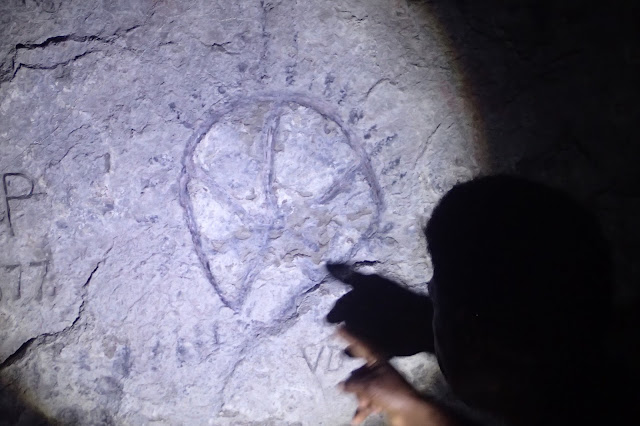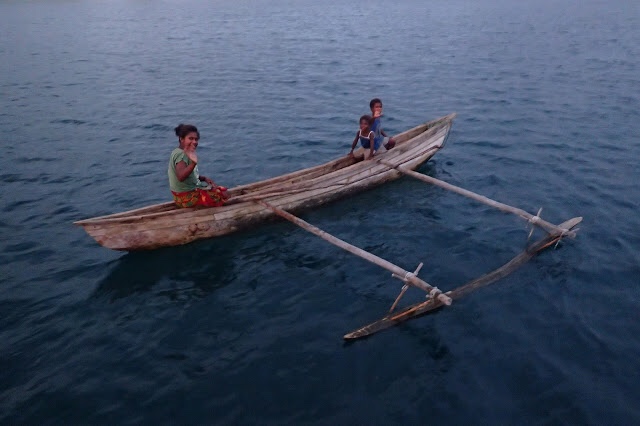 |
| Heading to "Hat Island" |
 |
| The restaurant was overpriced and under quality but the tree house was good. |
Our guide-book described 'the best hamburgers in Havannah Bay' at a nearby restaurant, so this was our obvious pick for dinner, but we were distinctly underwhelmed by our experience. The famous hamburgers were not on offer, as all the bread had been fed to the fish by the day-trippers from Port Vila, and when we chose a steak/fries combo instead, we ended up with a steak with pepper cream sauce at more than double what we had expected to pay; this place advertised 'cafe food' but they charged 'restaurant prices'. When I resisted, the owner was kind enough to make an adjustment for us, but although the food was tasty, we felt that the ambiance did not warrant the prices being charged. We learned later that most of their business is in the form of bus-loads of people who stop as part of their tour of Efate. There is a difference between tourist pricing and cruiser pricing!
We spent our first calm day at anchor doing boat jobs, including finally fixing the wiring for our anchor/tri-light, which had worked itself loose since it was installed in the Marshalls; it was fun for me to work on this job together, and even to do the splicing, while Max did another job in the saloon. It turned out that the grounding wire was connecting intermittently, which explained why both the anchor and tri-lights were acting up; I was able to re-splice the grounding wire without having to cut the others as well.
In contrast to our experience of eating in Havannah Bay, our guided tour was very memorable, and well worth the fee. This area of Vanuatu became the first UNESCO World Heritage site in the country about ten years ago, when three sites around the Bay were so designated in honour of 17th century Chief Roi-Mata, who brought peace to the area after a long period of warfare and in-fighting. Again, the majority of visitors come by the bus-load from Port Vila, and are taken to the three sites in a local fiberglass boat, but the Trust also makes arrangements with yachties to go with a guide in their own boat. When we went ashore to meet our guide, we were pleasantly surprised to find Richard, the Chairman of the Roi-Mata Trust, waiting to take us around, rather than one of his staff: we always love hearing stories directly from the most knowledgeable sources :)
 |
| Richard and the "Tam Tam" he made. |
Roi-Mata became the most powerful chief in the region after bringing together all the warring tribes for a peace ceremony: each group brought something from home to represent themselves (eg octopus, yam, rock, coconut, taro, banana, etc). Roi-Mata named each tribe according to its offering, and invited each group who had brought the same thing to gather and get to know each other as family. He also decreed that from that time onwards, people could only marry outside their named tribe: even to this day, Richard was able to tell us his Kustom name and the names of his father's and mother's tribes. By requiring marriages to occur across village and tribal lines, and by enforcing strict gift-giving protocols, Roi-Mata was able to institute a lasting peace amongst all the tribes and villages in the area. When he died as an old man (after a solo visit to a neighbouring village - I didn't understand from Richard whether suspicion was cast on that village or not, but elsewhere I read that he was assassinated) he went to Lelepa Island to 'pray his last prays' at Fels Cave and then to another hat-shaped island for burial. Apparently, the people didn't know how they would get his body from the village to the eventual burial site, but then the waters parted, and they were all able to process across the Bay. This struck us as a bit farfetched until we thought of our own Sunday-morning heritage, and realized that there may well have been a funny conversation when the first missionaries came and told the local people the story of Moses and the escape from Egypt: they would have exclaimed, "That sounds just like what happened to Roi-Mata!!"
Richard took us first to the site of Magaasi Village, on the mainland side of the Bay, where Roi-Mata had reigned as Chief. We were led up the paths through the woods from the beach to the entrance to the village, and shown the stones and shells along the way that would have originally formed the borders of the paths and a sturdy wall where Roi-Mata's bodyguards would have stood. Along the path, Richard showed us certain large stones, which even now children are not allowed to touch, that were believed to contain powerful magic to settle grievances, change the weather, cause harm to enemies, etc. The stones were set apart in clearings off the path, and were not to be approached or touched by the uninitiated. The village is no longer inhabited, but we had a sense of the importance of Roi-Mata from the way his living area was set apart due to the change in elevation and the walls. Richard also showed us a traditional tam tam, which is a vertical drum carved from a hollow log: it stands in the form of a person covered with intricate patterns, and is beaten with one or two heavy sticks. Tam tams were used to enable communications amongst the far-flung communities, with different rhythms having different meanings ("someone has died", "come to a meeting", etc). When the message was heard at a distance, it would be repeated on each village's tam tam until those at the furthest reaches of the region had received the news (the method reminded me of the 2nd story of the 101 Dalmations!). Although it looked very old, Richard had carved this particular tam tam himself in support of the development of the UNESCO World Heritage Site, basing his work on traditional designs.
 |
| Benjamin teaching Richard how to do Minecraft |


Upon our return to our dinghy, we motored the short distance across to Lelepa Island on the other side of the bay, and walked up a steep path to Fels Cave. After Roi-Mata's ill-fated participation in the feast with the other village (to which he did not bring his bodyguards) Roi-Mata went to Fels Cave to pray. We had the sense that the drawings on the walls dated not only from the present and from Roi-Mata's time (400 years ago) but from hundreds of years previously as well. The cave was a high-ceilinged sacred space, and recorded some of the history of the people and their chiefs, with marks on the walls to indicate peace ceremonies, pigs exchanged, babies born, etc. Richard pointed out to us that if we looked closely at the rock formations themselves, we could see the image of a baby pig in the ceiling. Roi-Mata's body had briefly laid in the cave, but there was a concern that his energy would taint the cave after his death (and that his body would be stolen), so it was important to his followers to move him to another location. They weren't sure how they would do this, and this is where the parting of the sea became important: they were able to move with their whole contingent to Eretoka (Hat) Island, so-named because its topography is so clearly reminiscent of a wide-brimmed hat, and all thanks to the work of the Spirits who hover close-by. Even during our tour, Richard credited the gap in the waves as we approached the beach in our dinghy to the Spirits of his ancestors who were watching over us.
The third site was an optional part of the tour, but we were glad to go there: we took Fluenta to Hat Island, sharing a lunch of fish, rice, and pamplemousse, followed by Tanna coffee, while we were underway, and anchoring off the north west corner of the island. Richard seemed quite pleased to have gotten out of his office and aboard a yacht, and excitedly used his smart phone to record a video of our transit to send to a UNESCO colleague in Australia :) He hadn't been back to Hat Island since he had done a post-Cyclone Pam survey in 2015, so it seemed meaningful to him that he had the opportunity to visit as well.
 |
| Moon cycle |
 |
| Recording graffiti for later removal |
 |
| Graffiti from a missionary |
The burial mound was probably the most unusual site of the whole tour. It was located in a clearing up a hill after a walk along the beach. Not only was Roi-Mata buried here, but many of his followers and bodyguards were as well. At a certain number of days after his death, they held a ceremonial feast to mark his passing and then upwards of 50 of the followers were laid down on a second layer of the grave, including one of Roi-Mata's wives who was laid beside him, and one of his small children who was buried at his feet. My understanding is that this feast took place 100 days after his death, as part of the traditional/ceremonial grieving process, and part of the ceremony involved dancing on the grave site to tamp down the dirt before the followers and bodyguards were placed on top to literally follow Roi-Mata into the afterlife. It seems that a significant amount of kava might have been part of their feast (and their willingness to sacrifice themselves). Richard told us that for hundreds of years, the site of the burial, which was taboo to visit, was kept clear of stray grass and leaves by the winds and the Spirits, but that after the ground was disturbed by an archeologist in the 1960's things weren't the same, with the grass and leaves having to be kept from the site manually, although now that the site is a UNESCO World Heritage site, and it is maintained with respect, the power of the Spirits is beginning to return. Regardless of the presence of magic at the site, or not, it was sobering to see the two grave markers for Roi-Mata and his wife, surrounded by shells and decorations, including his huge conch shell, and to see the ring of stone markers for each of the followers and body guards that formed a kind of fence around the area. Richard spoke sacred words in his traditional language to let the Spirits know that we had come from Canada to visit, and he thanked them for our visit when we left.
 |
| The Roi Mata burial site |
 |
| The Roi Mata burial site |
 |
| A photo we took at the National Museum showing the Roi Mata skeleton following the excavation |
All too soon, it was time to weigh our anchor in paradise to head for Port Vila, and the maintenance and travel arrangements that awaited us there. The kids and I spent a month in Canada, while Max had a month in his own company, doing innumerable boat jobs, and even having some afternoons to go kiting.
Whew! This seems long-winded and overdue, but I have finally caught you up on our pre-Canada movements, now that we have returned to the boat and arrived in New Caledonia. You have likely already seen photos of our extraordinary visit to the volcano on Tanna Island (think orange lava and rumbles that shook the earth), and stay tuned for news of our reunion with Honey (joyous) and our adventures in New Cal (think cold and windy - it is winter here, after all!)
Much love from Fluenta,
Elizabeth
-----
At 2017-09-03 10:39 PM (utc) SV Fluenta's position was 22°16.69'S 166°25.76'E










